Types of Addressing modes
- Implied / Implicit Addressing Mode
- Stack Addressing Mode
- Immediate Addressing Mode
- Direct Addressing Mode
- Indirect Addressing Mode
- Register Direct Addressing Mode
- Register Indirect Addressing Mode
- Relative Addressing Mode
- Indexed Addressing Mode
- Base Register Addressing Mode
- Auto-Increment Addressing Mode
- Auto-Decrement Addressing Mode
1. Implied Addressing Mode-
In this addressing mode,
- The definition of the instruction itself specify the operands implicitly.
- It is also called as implicit addressing mode.
Examples-
- The instruction “Complement Accumulator” is an implied mode instruction.
- In a stack organized computer, Zero Address Instructions are implied mode instructions.
(since operands are always implied to be present on the top of the stack)
2. Stack Addressing Mode-
In this addressing mode,
- The operand is contained at the top of the stack.
Example-
ADD
- This instruction simply pops out two symbols contained at the top of the stack.
- The addition of those two operands is performed.
- The result so obtained after addition is pushed again at the top of the stack.
3. Immediate Addressing Mode-
In this addressing mode,
- The operand is specified in the instruction explicitly.
- Instead of address field, an operand field is present that contains the operand.
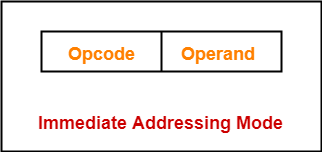
Examples-
- ADD 10 will increment the value stored in the accumulator by 10.
- MOV R #20 initializes register R to a constant value 20.
4. Direct Addressing Mode-
In this addressing mode,
- The address field of the instruction contains the effective address of the operand.
- Only one reference to memory is required to fetch the operand.
- It is also called as absolute addressing mode.
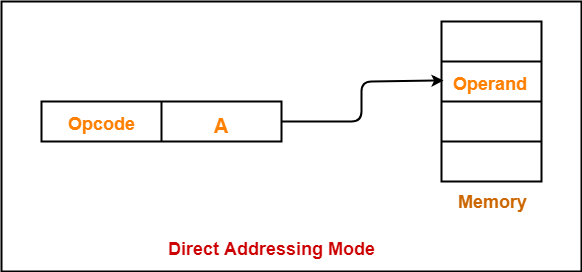
Example-
- ADD X will increment the value stored in the accumulator by the value stored at memory location X.
AC ← AC + [X]
5. Indirect Addressing Mode-
In this addressing mode,
- The address field of the instruction specifies the address of memory location that contains the effective address of the operand.
- Two references to memory are required to fetch the operand.
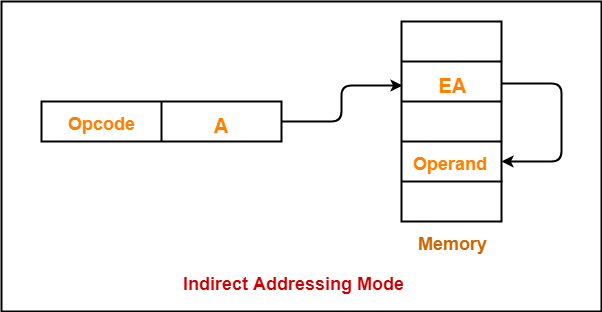
Example-
- ADD X will increment the value stored in the accumulator by the value stored at memory location specified by X.
AC ← AC + [[X]]
6. Register Direct Addressing Mode-
In this addressing mode,
- The operand is contained in a register set.
- The address field of the instruction refers to a CPU register that contains the operand.
- No reference to memory is required to fetch the operand.
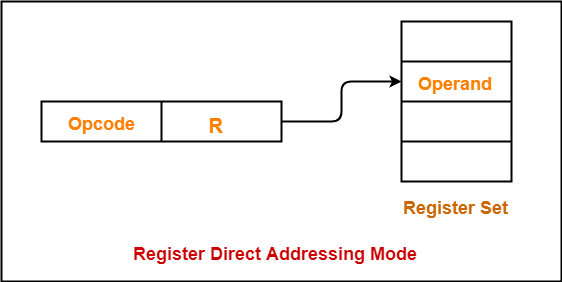
Example-
- ADD R will increment the value stored in the accumulator by the content of register R.
AC ← AC + [R]
NOTE-
It is interesting to note-
- This addressing mode is similar to direct addressing mode.
- The only difference is address field of the instruction refers to a CPU register instead of main memory.
7. Register Indirect Addressing Mode-
In this addressing mode,
- The address field of the instruction refers to a CPU register that contains the effective address of the operand.
- Only one reference to memory is required to fetch the operand.
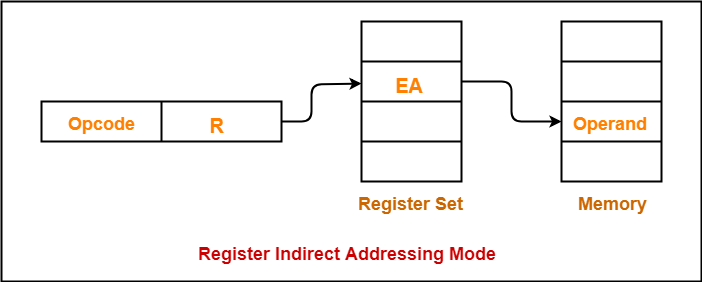
Example-
- ADD R will increment the value stored in the accumulator by the content of memory location specified in register R.
AC ← AC + [[R]]
NOTE-
It is interesting to note-
- This addressing mode is similar to indirect addressing mode.
- The only difference is address field of the instruction refers to a CPU register.
8. Relative Addressing Mode-
In this addressing mode,
- Effective address of the operand is obtained by adding the content of program counter with the address part of the instruction.
| Effective Address = Content of Program Counter + Address part of the instruction |
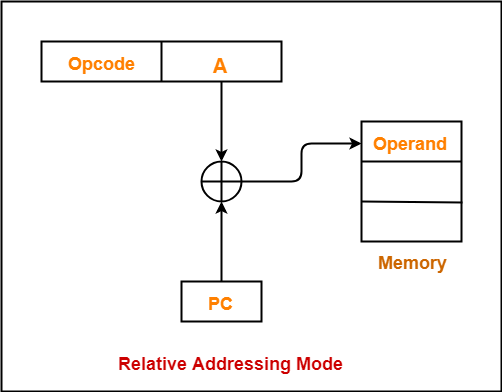
NOTE-
- Program counter (PC) always contains the address of the next instruction to be executed.
- After fetching the address of the instruction, the value of program counter immediately increases.
- The value increases irrespective of whether the fetched instruction has completely executed or not.
9. Indexed Addressing Mode-
In this addressing mode,
- Effective address of the operand is obtained by adding the content of index register with the address part of the instruction.
| Effective Address = Content of Index Register + Address part of the instruction |
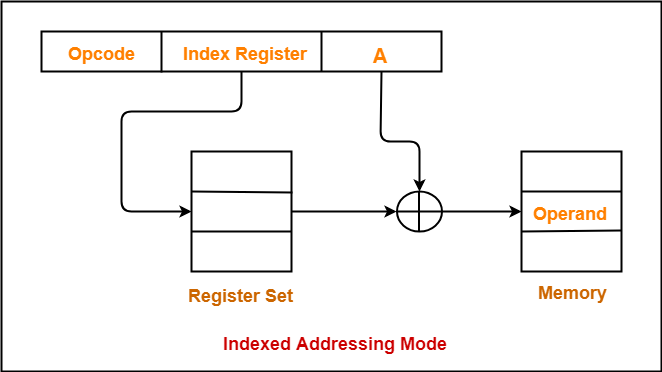
10. Base Register Addressing Mode-
In this addressing mode,
- Effective address of the operand is obtained by adding the content of base register with the address part of the instruction.
| Effective Address = Content of Base Register + Address part of the instruction |
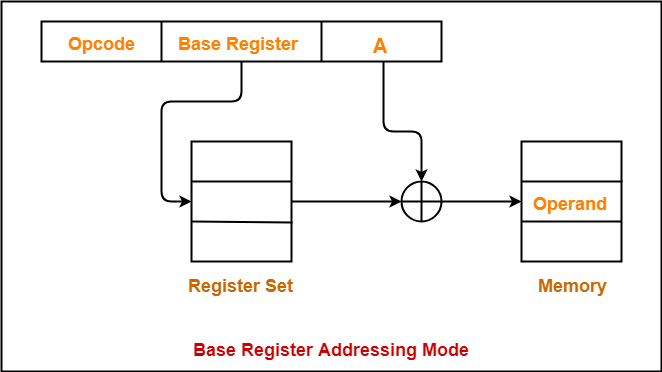
11. Auto-Increment Addressing Mode-
- This addressing mode is a special case of Register Indirect Addressing Mode where-
| Effective Address of the Operand = Content of Register |
In this addressing mode,
- After accessing the operand, the content of the register is automatically incremented by step size ‘d’.
- Step size ‘d’ depends on the size of operand accessed.
- Only one reference to memory is required to fetch the operand.
Example-
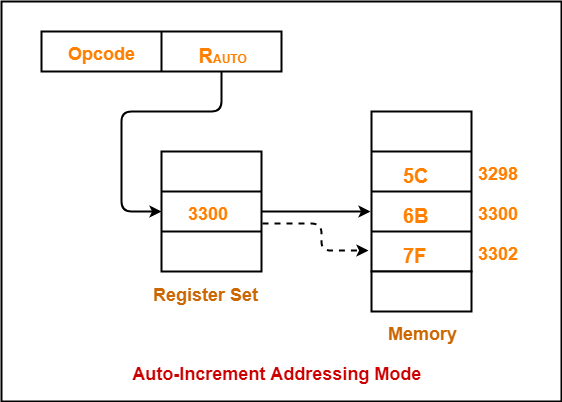
Assume operand size = 2 bytes.
Here,
- After fetching the operand 6B, the instruction register RAUTO will be automatically incremented by 2.
- Then, updated value of RAUTO will be 3300 + 2 = 3302.
- At memory address 3302, the next operand will be found
12. Auto-Decrement Addressing Mode-
- This addressing mode is again a special case of Register Indirect Addressing Mode where-
| Effective Address of the Operand = Content of Register – Step Size |
In this addressing mode,
- First, the content of the register is decremented by step size ‘d’.
- Step size ‘d’ depends on the size of operand accessed.
- After decrementing, the operand is read.
- Only one reference to memory is required to fetch the operand.
Example-
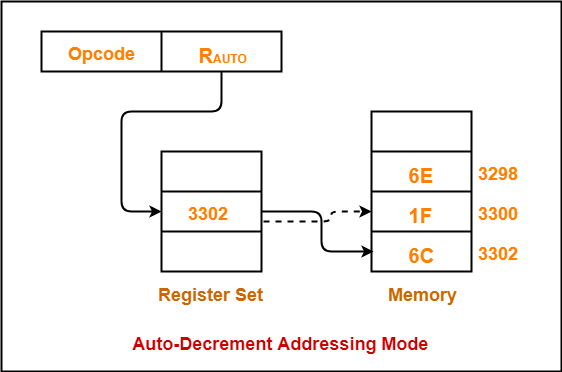


Comments
Post a Comment